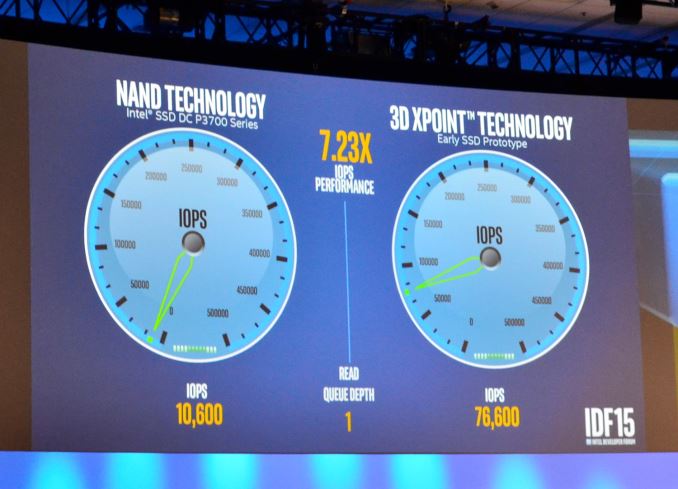Intel Announces Optane Storage Brand For 3D XPoint Products
by Ryan Smith on August 18, 2015 2:15 PM EST
At IDF 2015 this year Intel has announced that their forthcoming 3D XPoint technology based products will be sold under a new brand for the company, Optane.
The Optane products will be available in 2016, in both standard SSD (PCIe) form factors for everything from Ultrabooks to servers, and in a DIMM form factor for Xeon systems for even greater bandwidth and lower latencies. As expected, Intel will be providing storage controllers optimized for the 3D XPoint memory, though no further details on that subject matter were provided. This announcement is in-line with Intel and Micron’s original 3D XPoint announcement last month, which also announced that 3D XPoint would be out in 2016.
Finally, as part of the Optane announcement, Intel also gave the world’s first live 3D XPoint demonstration. In a system with an Optane PCIe SSD, Intel ran a quick set of live IOps benchmarks comparing the Optane SSD to their high-end P3700 SSD. The Optane SSD offered better than 5x the IOps of the P3700 SSD, with that lead growing to more than 7x at a queue depth of 1, a client-like workload where massive arrays of NAND like the P3700 traditionally struggle to achieve maximum performance.












50 Comments
View All Comments
prime2515103 - Tuesday, August 18, 2015 - link
Did they say anything about data retention? I heard recently that SSD's have a data shelf life of two years (as in, if you unplug it and store it, in two years the data will be gone).melgross - Wednesday, August 19, 2015 - link
That's been disproven. This is supposed to have 1,000 times the write lifetime, per cell, of NAND. Possibly more.Jaybus - Friday, August 21, 2015 - link
Retention is a different matter than maximum write cycles. Nevertheless, NAND flash data retention is dependent on maximum write cycles. It is also temperature dependent, which lead to a scare a while back. Under normal storage conditions (<= 30 C) Data retention for MLC NAND flash is around 10 years for a new drive, falling to 28 months for a drive that has reached its maximum write endurance. That falls to a matter of days when the storage temperature exceeds 55 C.But does it matter? Who is going to use expensive SSDs for archival storage?
eek2121 - Tuesday, August 18, 2015 - link
Intel has already hinted that these things won't be cheap. They are meant to be superior to current SSDs. You will likely see prices of $3-$5 per gig, and this product will most definitely be targeting the enterprise.Impulses - Wednesday, August 19, 2015 - link
They'd probably sell some to enthusiasts/pros even at those prices, it'd make a 128GB about $400-650, 256GB $750-1,250. I'm pretty sure that's STILL cheaper per GB than the X25-M was originally.gospadin - Wednesday, August 19, 2015 - link
The original Intel X25-M 80GB was $595, which is about $7.50/GB.http://www.anandtech.com/show/2614
valnar - Wednesday, August 19, 2015 - link
Take my money now!melgross - Wednesday, August 19, 2015 - link
Remember that the first SSD cost $3,600 for 32GB. So this will be pretty cheap when compared to that, and may give some idea as to how prices could drop over the years.AnnonymousCoward - Wednesday, August 19, 2015 - link
So how do you convert IOPS to actual performance?In SSDs' case, 50x more IOPS than HDDs bought about 3x single-operation performance. By the same ratio, 7x buys +42%, and if anything it'd be a lot lower since other system components will become the bottleneck. I know these are extremely rough numbers but you get the idea.
TelstarTOS - Friday, August 21, 2015 - link
Shut up and take my money!